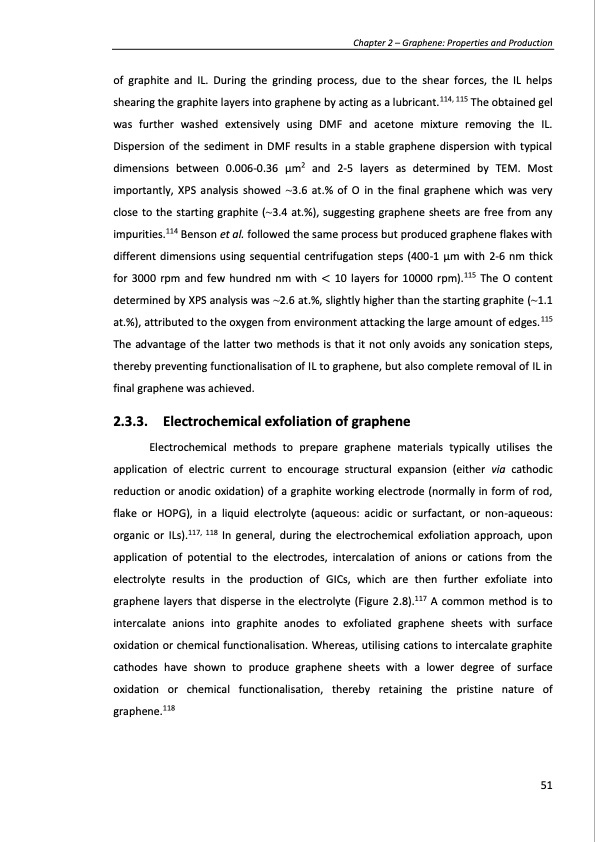
PDF Publication Title:
Text from PDF Page: 051
of graphite and IL. During the grinding process, due to the shear forces, the IL helps shearing the graphite layers into graphene by acting as a lubricant.114, 115 The obtained gel was further washed extensively using DMF and acetone mixture removing the IL. Dispersion of the sediment in DMF results in a stable graphene dispersion with typical dimensions between 0.006-0.36 μm2 and 2-5 layers as determined by TEM. Most importantly, XPS analysis showed ~3.6 at.% of O in the final graphene which was very close to the starting graphite (~3.4 at.%), suggesting graphene sheets are free from any impurities.114 Benson et al. followed the same process but produced graphene flakes with different dimensions using sequential centrifugation steps (400-1 μm with 2-6 nm thick for 3000 rpm and few hundred nm with < 10 layers for 10000 rpm).115 The O content determined by XPS analysis was ~2.6 at.%, slightly higher than the starting graphite (~1.1 at.%), attributed to the oxygen from environment attacking the large amount of edges.115 The advantage of the latter two methods is that it not only avoids any sonication steps, thereby preventing functionalisation of IL to graphene, but also complete removal of IL in final graphene was achieved. 2.3.3. Electrochemical exfoliation of graphene Electrochemical methods to prepare graphene materials typically utilises the application of electric current to encourage structural expansion (either via cathodic reduction or anodic oxidation) of a graphite working electrode (normally in form of rod, flake or HOPG), in a liquid electrolyte (aqueous: acidic or surfactant, or non-aqueous: organic or ILs).117, 118 In general, during the electrochemical exfoliation approach, upon application of potential to the electrodes, intercalation of anions or cations from the electrolyte results in the production of GICs, which are then further exfoliate into graphene layers that disperse in the electrolyte (Figure 2.8).117 A common method is to intercalate anions into graphite anodes to exfoliated graphene sheets with surface oxidation or chemical functionalisation. Whereas, utilising cations to intercalate graphite cathodes have shown to produce graphene sheets with a lower degree of surface oxidation or chemical functionalisation, thereby retaining the pristine nature of graphene.118 Chapter 2 – Graphene: Properties and Production 51PDF Image | PRODUCTION AND APPLICATIONS OF GRAPHENE AND ITS COMPOSITES

PDF Search Title:
PRODUCTION AND APPLICATIONS OF GRAPHENE AND ITS COMPOSITESOriginal File Name Searched:
graphene-production-applications.PDFDIY PDF Search: Google It | Yahoo | Bing
Salgenx Redox Flow Battery Technology: Power up your energy storage game with Salgenx Salt Water Battery. With its advanced technology, the flow battery provides reliable, scalable, and sustainable energy storage for utility-scale projects. Upgrade to a Salgenx flow battery today and take control of your energy future.
| CONTACT TEL: 608-238-6001 Email: greg@infinityturbine.com | RSS | AMP |